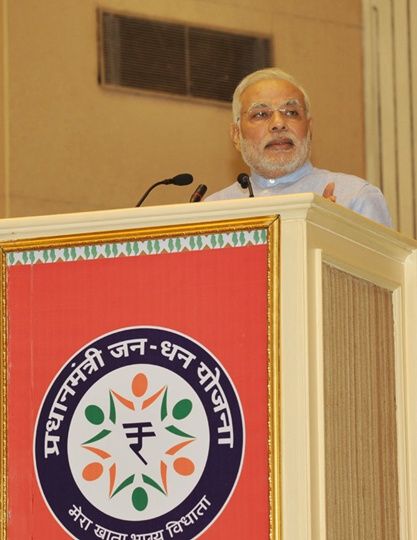
Paucity of information regarding the progress of financial inclusion in India has been a major challenge. The situation is now changing, with data being made available online, notes Sumita Kale
A glance at recent media headlines on the Pradhan Mantri Jan-Dhan Yojana would lead one to think that India’s financial inclusion mission is floundering, as a few negative trends that have come out through MicroSave’s third round of assessment of the scheme are grabbing all the attention.
It is, of course, perfectly rational to stress where the mission is going wrong and where corrections are needed.
Yet, in India, and in a mission this size, it is difficult to imagine getting everything right from the very beginning.
In fact, there is much to be said about the positive trends that have emerged through the assessments, to get a more balanced picture.
More importantly, the assessment of PMJDY should be done within the context of the programme.
To begin with, the PMJDY has dramatically changed the basic framework of financial inclusion in India.
For long, progress in inclusion has been measured by the number of no-frills or basic savings bank accounts and the number of branchless outlets in villages.
Apart from some occasional surveys by independent agencies, little or no data has been available on the usage of these accounts, dormancy of agents, income earned by agents, etc.
One of the biggest challenges for researchers like us in tracking the progress of financial inclusion in India has been the paucity of data at the granular level.
So we have the Reserve Bank of India Annual Report, 2014-15, stating that there are 504,142 branchless banking outlets in villages, with no granular information regarding location details, activity levels, etc.
It is not clear, from any publicly available database, whether the 126,000 agents used as Bank Mitras under the Sub-Service Area Scheme for PMJDY form a subset of the aggregate shown in the RBI data, or whether there is some overlap between the two data sets.
Unlike the PMJDY Bank Mitras, whose data are now available on the website, information on non-PMJDY business correspondent outlets has to be gleaned from State Level Bankers’ Committees, which have varying standards of reporting and monitoring. Studies conducted in the pre-PMJDY era by the Consultative Group to Assist the Poor and MicroSave on BC availability (CGAP’s “National Survey of Banking Agents, 2013” and “The Curious Case of Missing Agents in Rural India”, MicroSave, January 2014) showed that data on agents, as reported by SLBCs, often did not match data from on the ground.
The recommendation from Indicus Centre for Financial Inclusion (Policy Brief, November 2015) was for the Department of Financial Services and the RBI to coordinate towards a harmonised and current database of all BC agents in the country that will provide a clear and full picture of the actual financial inclusion footprint in the country.
This recommendation was included by the RBI Committee for the Medium-term Path to Financial Inclusion (January 2016) and the first bi-monthly monetary policy statement for this year has set out the task of a tracking system for BCs: an online registry of all BCs -- both existing and new -- that will capture basic details, including location of fixed-point BCs, nature of operations, etc, updated on a quarterly basis.
It is often forgotten that the PMJDY is just one part of the overall network set out in the country, a network for which data are still scarce.
In this situation, it is heartening to see that the PMJDY Mission Directorate has progressed from monitoring only the number of accounts to tracking a number of indicators such as Aadhaar seeding, provision of RuPay cards, usage of overdraft facility, payment of Bank Mitra remuneration, etc, and transaction readiness of Bank Mitras.
There is transparency now.
With state- and district-level data available on the PMJDY website and with a geographic information system locator available online for banking services, it is much easier for any independent analyst to cross-verify the basic existence of a BC agent.
Though a lot more remains to be monitored -- for example, the number of transactions at the agent and account level, connectivity issues at the BC outlet, customer care and grievance redressal -- it is important to appreciate this sea change within the DFS and the RBI to start tracking progress indicators at a granular level and beyond the aggregate number of agents and accounts.
The second significant change under the PMJDY is that the financial inclusion objective has moved beyond the provision of simple no-frills accounts to meeting overall financial needs of the poor, linking government benefits, overdraft facility and insurance and pension to these savings accounts.
The massive campaign around PMJDY led to a surge in awareness, and for the first time in decades, bank officials, who would pursue people to open accounts to meet their mandated targets, reported being pushed by customers themselves.
The three rounds of assessment by MicroSave must be seen in this perspective: as a survey that provides for a much richer analysis of course correction where needed for the PMJDY Mission Directorate.
The good, the bad and the ugly from the survey results will be taken up in the next piece.
Image: Prime Minister Narendra Modi addressing at the launch of the ‘Pradhan Mantri Jan Dhan Yojana, in New Delhi. Photograph: Kind courtesy, PIB
Sumita Kale is with the Indicus Centre for Financial Inclusion; She can be reached at sumita@indicus.org











